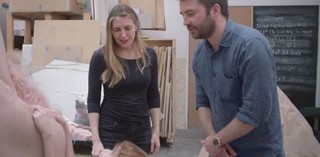Patricia Piccinini gives us an insight into studio life

In preparation for the exhibition ‘Patricia Piccinini: Curious Affection‘, it was necessary to make progress visits to Piccinini’s studio in Melbourne to keep pace with her immense creative output. With so much to say about her work, and so many interesting people responsible for a giddying array of techniques, it was important that we record these visits to share.
I made the pilgrimage with the Gallery cinematographer on three occasions to capture the work flow and listen to Piccinini’s ideas evolve, with so much activity to document, filming days stretched into the night. Back in Brisbane we sorted through days of footage to construct this immensely watchable introduction to the artist, her studio, and her new artworks.
Related: Patricia Picinini
‘Curious Affection’ is Piccinini’s most ambitious exhibition to date, it includes a suite of immersive multisensory installations – including a large-scale inflatable sculpture – especially conceived for GOMA’s expansive spaces. Occupying the entire ground floor, the exhibition also includes a retrospective of her most recognisable works from the past 20 years.
Piccinini is unquestionably one of Australia’s most imaginative, thoughtful, and exacting artists. This-behind-the-scenes look into the ideation, creation, and fabrication process that inform studio life provides a rare insight into the workings of her formidable team. At the same time it also introduces many of the artists key themes and inspirations in her own words. This documentary has been paired with her exhibition walk-through highlighting four of her most recent works.
These videos goes a long way to introducing Piccinini’s enchanting and heartfelt vision. Enjoy.
Peter McKay is Curator, Contemporary Australian Art, QAGOMA
Behind-the-scenes with Patricia Piccinini
Subscribe to QAGOMA YouTube to be the first to go behind-the-scenes / Behind-the-scenes documentary created by Peter McKay, Exhibition Curator and Curator, Contemporary Australian Art, QAGOMA; Jeremy Virag, QAGOMA cinematographer and film grading; Shih-Yin Judy Yeh, QAGOMA Cinema Technical, editing.
Walk through the exhibition with Patricia Piccinini
Subscribe to QAGOMA YouTube to be the first to go behind-the-scenes / Exhibition walk-through created by Peter McKay, Exhibition Curator and Curator, Contemporary Australian Art, QAGOMA; Jeremy Virag, QAGOMA cinematographer and film grading; and Denny Ryan, QAGOMA Cinema Technican, editing.
Subscribe to YouTube to go behind-the-scenes / Read more about your Australian Collection
Stay Connected: Subscribe to QAGOMA Blog
‘Patricia Piccinini: Curious Affection‘ / Gallery of Modern Art (GOMA) / 24 March – 5 August 2018.
Feature image: Peter McKay (right) with Patricia Piccinini in her Melbourne studio

